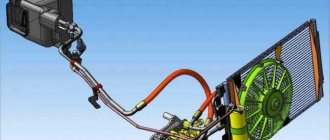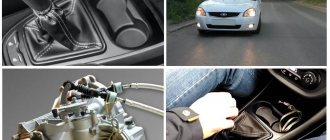AvtoVAZ is not doing well with gearboxes, even if you cry. Such a pun appeared at the very beginning, although some are not in the mood for jokes, since they became the owners of Tolyatti products. With the release of the Lada Vesta, the situation seemed to begin to “settle down,” but, again, not without the help of the foreign automobile industry. Let's try to figure out which transmission the VAZ team turned out to be better and more efficient, although, to be honest, there are not so many of their own developments there. As we continue our research, we will use the opinions of our motorists.
Lada Vesta with automatic transmission, robot or mechanics?
With the advent of AvtoVAZ's new product on the market, a lot of interest was generated in this car.
The vehicle has a dynamic appearance and decent tactical and technical characteristics. The Lada Vesta automatic is a significant alternative to versions with a manual transmission. Each model is characterized not only by the power of the internal combustion engine, the chassis, but also by the gearbox. A large number of consumers are worried about the choice: manual or automatic. Here, a lot depends on the needs of the owner and the equipment of the car itself. AvtoVAZ has already used a robotic gearbox on previous versions of the Lada model range (Granta, Kalina). At that moment, AMT completely replaced automatics. The opinions of owners and professionals agree that this box has enormous advantages, and the French Renault even has plans to introduce a “robot” from Russian engineers to its models.
The price of a Lada Vesta with automatic transmission varies depending on the configuration. The cheapest option will be the Classic 1.6 AMT, which can be purchased for 595 thousand rubles. Luxe Multimedia 1.8 with automatic transmission is purchased for 740,000 rubles. The cost of a car with a manual transmission is lower than the price with an automatic transmission.
The choice between replacing and repairing a manual transmission
French-made manual transmissions are very repairable, but spare parts for their restoration are not always available. Therefore, sometimes it is easier to purchase a new or contract unit. The cost for a new manual transmission starts from 40 thousand rubles. The contract unit has a price of 6,000 rubles.
Domestic-made mechanical boxes are mainly repaired. From a major overhaul to the next overhaul, a manual transmission can cover 150-200 thousand km. Car owners usually buy a new box or contract unit only if the unit has serious deformations or significant wear. From an official dealer, a mechanic costs from 35 thousand rubles, and from a car wrecker - from 5,000 rubles.
What kind of automatic machine does the Lada Vesta have?
Automatic and manual transmissions The new product has two transmission options: domestic automatic and French manual.
Since many tests of the car were carried out (automatic test drive video below), we can confidently talk about the pros and cons of the first and second gearboxes. The difference between AMT (robot) and automatic transmission is quite significant. On the latter, switching occurs without driver participation. The first, in fact, is a mechanics modified by an electrical unit.
The global market has shown that the frequency of implementation of AMT in vehicles is beginning to fall, this is due to the following factors:
Features of AMT in comparison with Lada Vesta automatic
Robotic gearbox Russian designers decided to take a risk and create their own robot with five stages, relying on the advantages:
In their development, domestic designers took into account the experience of foreign engineers and began to use German actuators (actuators), as well as a French-made clutch for their transmissions. An option for clutch wear compensation is installed inside the AMT Lada Vesta. In addition, it does not need to be warmed up before starting work. An automated manual transmission weighs much less than an automatic transmission, which reduces gas mileage when driving.
A Lada Vesta car with a robotic gearbox cannot be left on a rolling surface without fixing the hand brake. Otherwise, it will move backward, which can lead to an emergency.
Adviсe
If you've driven a manual car all your life, take a car with a robot. Don't listen to anyone.
- If something fails, there is a guarantee.
- VAZ gearbox installed.
- Actuators made in Germany. They depress the clutch and change gear for the driver. They are inexpensive to repair.
If you decide to buy a manual with a robot, then know that now AvtoVAZ no longer installs Renault boxes, but only its own VAZ ones. I believe that it is better to buy a Lada Vesta with a VAZ gearbox, but with German actuators. Yes, it will not be as playful as with a manual transmission. But it will be convenient for city driving. This is a good and cheap option.
Automatic transmission problems for the Russian new car
Automatic transmission The idea of installing an automatic transmission is in the minds of Russian designers, but to bring it to life, special circumstances and high costs are needed.
Management is already negotiating with foreign investors on the construction of a new enterprise, which will be equipped with everything necessary. Don’t forget: the Togliatti plant is focused on selling cars to the middle class of consumers. Information has appeared that they are launching a test drive to examine the operation of the automatic transmission (4 gears). VAZ directors rejected this news and said that if development begins, the automatic will be six-speed.
If you thoroughly understand which is better: a Lada Vesta automatic or a robot, it will take a lot of time. Both modifications have their own distinct pros and cons, visible to the naked eye.
CVT for Lada Vesta
The Franco-Japanese corporation Renault Nissan is providing Russian designers with a CVT, which they plan to install on AvtoVAZ’s new product. This device has proven itself when used on units that require a stepless reduction or increase in the gear ratio.
Russian enthusiasts will have to wait for this device to arrive on the markets, as it will be installed together with a reliable and powerful new engine from the Renault-Nissan alliance. Now is the time to evaluate the work of both the robot and the automatic transmission, and then compare them with a rare phenomenon for the domestic automotive industry - a CVT. It’s difficult to say how much this device costs.
Source
Comparison of Lada Vesta transmission options
We have 4 Lada Vestas and they are all different. In previous reviews, I talked about all the engine options that are available for this model. If anyone hasn't read it, I'll leave a link at the end of the article.
Today there will be an equally unique review. In one place I collected 4 Vestas with different transmissions that are available for it: 2 options of 5-speed manual and 2 automatic transmissions - a robot and a CVT. Let's discuss each of the options, their pros and cons, and draw conclusions. I’ll also give you a little life hack on how to accurately find out the type of Vesta transmission by its VIN number.
Technical parameters of the VAZ 21807 gearbox
Finally, understand that it will not become better for dealers who sell foreign cars, it is falling in price and it is especially not valued in trading, if you don’t believe it, go to the dealer’s showroom and let them evaluate it - you will go crazy at their price. in position R, using the Grade-X diagnostic device in the Monitoring mode - Input and output parameters, check the execution of the operation of deleting calibration results according to the state of the Self-learning flag parameter, see.
VAZ mechanics
Let's start with the simplest and most affordable option. This is a VAZ 5-speed manual transmission with the VAZ-21807 index. It works with an engine with index 21129 with a displacement of 1.6 liters and a power of 106 hp. With.
The box, due to its design, holds torque up to 170 N*m. The transmission is a deeply modernized VAZ-2112 gearbox. Structurally, like the previous version, it is combined with a differential and a main gear, the gear ratio of which is 3.9.
The design of the gearbox remains unchanged. Unlike its predecessor, this box was freed from rigid traction, and the control mechanism received a cable drive, like in foreign cars. This solution allowed to reduce noise and vibration levels. Gears began to engage more clearly, and shift strokes decreased.
The instruction manual states that the oil filled from the factory is designed for the entire service life of the unit and does not require replacement. But I think that this point was most likely prescribed by marketers, not engineers. Therefore, I advise you to change the oil at least every 75 thousand kilometers, or 4 years of operation of the car, whichever comes first.
In terms of reliability, the option performs very well. The first versions of this box often had problems with the 1st and 2nd gear synchronizers, which quickly wore out. There was a characteristic crunch when switching, there were problems with the shaft bearings, which could begin to hum already in the early runs. The 807 box does not have these problems.
The only unpleasant moment that you may encounter at high mileage is oil leakage through the sealant at the junction of the gearbox housings.
Pros and cons of mechanics
This is the cheapest and simplest manual transmission that can generally be found on a new car. Taking into account the modifications, it can be called reliable and unpretentious. She doesn't require any attention. The resource of the box is 150-200 thousand km. Its repair in any service will not require a lot of money and time.
There is one drawback - of all the available options, the box is the noisiest. Transmission noise has become less compared to the traditional VAZ gearbox. But it can still be heard in the cabin in certain driving modes, especially when releasing the gas in 1st and 2nd gears. AvtoVAZ engineers were able to completely eliminate the remaining defects.
Robotic gearshift lever diagram
Moreover, the clutches close most quickly when you carefully operate the gas; when starting “to the floor,” there is again a clear pause in operation, but even in this case there are no jerks.
The most unpleasant outcome is, again, when copying the “automatic” algorithms of machines with classic gas turbine engines.
If you sharply press the gas at the start and then release it, there will be a pause at the start, a jerk, and an unpleasant vibration of the engine.
In general, you need to handle the gas pedal as carefully as if you had a simple “mechanics”. When the clutches overheat, for example, in the case of frequent starts in a traffic jam with a high load, they promise a tougher engagement, but I could not bring the box to this mode.
The robotic gearbox on the Lada Vesta is a convenient and reliable analogue of an automatic transmission. The unit is AVTOVAZ’s own development and will be used in the future not only on Lada cars, but also on models of the Renault-Nissan alliance.
In this article we will talk about the robotic gearbox of the Lada Vesta, why this particular automatic transmission is installed on the car at the moment and what problems with the robot occur most often. You can also read real reviews from people about the AMT robotic gearbox on the Lada West and what difficulties they have already encountered during operation.
Home / Information / Lada Vesta SV Cross AMT (robot): reviews, video, acceleration
At the end of 2022, the brainchild of AvtoVAZ went on sale - the new LADA Vesta SW Cross station wagon, which has already made a good splash. People are interested and search for information on the Internet, look at reviews, stand in line at car dealerships... And for good reason. The car turned out to be very beautiful and inexpensive, unlike its predecessors.
Robot AMT
The third option is the simplest and most affordable two-pedal automatic transmission option. AvtoVAZ tried for a long time to create its own automatic machine. But there was no experience and developments in this direction. Therefore, they turned to foreign specialists from the German company ZF for help.
The result of this collaboration was the famous VAZ robot. Structurally, it is the same 5-speed manual transmission of the VAZ-2180, to which, during the modernization process, 2 actuators were added that do all the work for you: clutch and gear shift actuators.
This transmission has the VAZ-21827 index. The first robot was installed on the Lada Priora in 2014. Then it was installed on Grant. Subsequently, he reached Vesta and X-Ray. At the time of review, the robot is only available for the Lada Granta.
The first versions of the robot had an index of 21826, and there, in order for the car to start moving in “drive” mode, you had to press the gas pedal. I think this is not very convenient for an automatic transmission. Later we made a new firmware and added a “crawling” mode. That is, the car in “drive” mode began to move automatically after releasing the brake pedal. The box index became 21827.
The good thing about the robot is that it is not particularly demanding. It does not have special operating conditions that must be strictly observed in order for the unit to serve for a long time and without problems. If you compare it with a CVT, which has many “buts” and “don’ts,” then with a robot everything is really simple. It does not need to be warmed up before driving, it can be skidded, it is allowed to be towed. Dynamic driving is allowed. The oil change procedure costs only 2,500 rubles. That is, of all automatic transmissions, the robot is the simplest, most affordable and unpretentious transmission.
Pros and cons of the robot
Since it is the same VAZ 5-speed manual, it will be just as reliable, unpretentious, maintainable and inexpensive to maintain and repair. Actuators are expensive, but there are no problems with them in operation. Unless the clutch actuator with high mileage may begin to squeak. But this can be solved easily and quickly by removing, disassembling and lubricating.
Of the minuses, there were several nuances. Firstly, there were problems with the clutch discs. This manifested itself in the form of increased vibration of the transmission at the beginning of movement. The clutch disc manufacturer has modernized them several times and changed the composite composition of the friction linings. But this problem could not be completely solved.
The second negative point of the robot is that when driving in traffic jams, when there is frequent starting, the transmission may overheat. The box will go into emergency mode and the car will stop moving. It will take some time for the mechanism to cool down. Otherwise there were no problems.
New technologies in domestic production
Buyers choosing a new car look thoughtfully at the new AMT from Lada. What is it, what is its operating principle? In fact, this is a regular manual transmission, only it does not have a clutch pedal. Instead of three levers, you only get two - gas and brake. The compact gearbox has off, on and shift modes, which replace the familiar pedal.
Reviews of the Lada Vesta robot show that not everyone liked the manufacturer’s innovations. The automated gearbox is developed on the basis of the manual transmission of VAZ cars. The control system uses the latest ZF developments, which help to change gears faster. In terms of quality, the new AMT is clearly better than the old technologies on the Lada Kalina, but at the same time inferior to European analogues (BMW, Ford, etc.). What positions are there on the shift lever in the new Lada Vesta?
- Auto mode – allows you not to think about changing gears at all.
- Neutral position is acceptable when the car is parked.
- Reverse – in this position, as you might guess, the car will go backwards.
- Manual shift - allows you to change gears yourself if you want to overtake someone or save fuel. If you want to downshift, then you don’t have to touch the lever at all - the Lada itself will do everything for you if you take your foot off the gas pedal.
Variable speed drive
The fourth transmission option available for the Lada Vesta is the Jatko JF015E CVT. It works with a 1.6-liter Nissan H4M engine producing 113 hp. With.
The engine is assembled in Togliatti, and the variator is supplied assembled from Japan. The CVT has been used since 2010 and is installed in many Renault Nissan Alliance models with small-volume engines up to 1.8 liters.
The CVT transmission is the most technically complex compared to other options. Therefore, it will be significantly more expensive in maintenance, repairs and components. The unit is combined. It uses a torque converter, which serves as a buffer for dynamic loads, a variator and a two-stage planetary gearbox.
What's good and bad about a CVT transmission?
The first is the level of comfort. Of all the options available for Vesta, the CVT will be the best offer in terms of comfort. Gear shifting occurs very smoothly, without jerking, almost imperceptibly. Provides a high level of acoustic comfort in the car interior. There is no noise and hum that a conventional manual transmission gives.
Driving through traffic jams in a metropolis in a Lada Vesta with a CVT is much more pleasant and comfortable than in a Vesta with other types of transmission. For a familiar perception of gear shifting, a 6-speed simulation function is provided.
The second advantage of the variator is that, unlike a classic automatic transmission, due to its design, compact body, and low weight, it provides the vehicle with fuel efficiency at the level of manual transmissions. This is why CVTs have always been loved and appreciated. As AvtoVAZ representatives stated, the choice of a CVT rather than an automatic was due precisely to this factor.
On average, consumption on a Vesta with a CVT is 7.5-8 liters per 100 km in the combined cycle. For comparison, the lighter Granta with a classic 4-speed automatic transmission from the same Jatko company consumes all 12 liters in the combined cycle. The difference is significant and obvious. Automatic machines are already really outdated and are good only because they can hold a lot of torque. But they are inferior to the CVT in terms of efficiency and environmental friendliness.
The efficiency of an automatic transmission is less than that of a variator.
How long will the variator last?
The more often you change the oil, the longer the variator will last. It is the replacement of lubricant that allows you to remove metal shavings and friction dust, which inevitably forms during operation. All problems and breakdowns come from it.
When changing the oil, you need to change the coarse and fine filters, as well as clean the magnets. The procedure will cost approximately 20 thousand rubles. It is recommended to do it every 50 thousand km.
It is very important to maintain the correct viscosity. Recommended oil is CVT Fluid NS-3. It is more liquid and does not thicken as much in winter.
NS2 is not suitable for winter, as it thickens more, so the valve body fails faster. I believe that the CVT transmission is aimed at a specific target audience. That is, the CVT is better suited for drivers who love comfort and adhere to a calm, measured driving style.
Test drive by specialists
What do professionals say about the robot box in Lada Vesta? You can find many reviews of the new product on the Internet. Most note the slow response of the box during acceleration. Some call the driving style of the Lada Vesta robot a style for summer residents. Slow acceleration of the car contributes not only to fuel economy, but also to passive safety. No matter how hard you try to squeeze out maximum speed in order to overtake three or two cars, it is unlikely that you will be able to do it quickly. True, the car behaves a little more cheerfully in manual mode, in which it is more realistic to squeeze the maximum out of the 1.8-liter engine. But, if you get used to this driving style, you begin to notice the advantages: the parts are made well and do not fail for a long time. Compared to manual and automatic transmissions, AMT provides significant fuel savings.
After the driver presses on the gas and the engine picks up speed, the transmission begins to upshift. The problem is that the robot on the Vesta cannot do this without reducing the thrust. The switching time fluctuates around 2 seconds, which can be quite annoying at first. But you won’t feel any jerks, the clutch is as smooth and comfortable as possible. In the reviews of the owners of the Lada Vesta robot in 2022, you can find a comic name for this driving style - driving a Chinese dummy. Due to the excessively sharp speed difference between first and second gear, Vesta drivers and passengers nod due to uneven acceleration.
But, despite various points of view, most reviews about the Vesta 1.8 robot indicate that the introduction of an automated manual transmission was a big leap forward for the domestic manufacturer. Car enthusiasts hope that the improvements will not end there; Lada engineers will properly finalize the box, and it will be a pleasure to drive. By the way, on the official website of the automaker there is already a survey on what users would like to change in the AMT box. So you should be patient - improvements are just around the corner.
conclusions
What conclusions can be drawn based on the above? Each transmission option will have its own pros and cons, strengths and weaknesses, advantages and disadvantages. Which one to choose, I think, everyone will decide for themselves.
If you are not spoiled by automatic transmissions, it’s easy for you to press the clutch and change gears yourself, and you don’t really want to bother with the nuances of operation and maintenance, then classic mechanics will be a good option for you.
If you want comfort and are willing to pay for it, then a robot or a CVT will be a good offer. In the comments, be sure to write which transmission option for the Lada Vesta is the best, and why. Share your ownership experience, write comments, ask questions.
Source
LADA Vesta: which version is better - with “mechanics” or CVT
Let's start with the fact that you need to choose the transmission according to your driving style. If you prefer high-speed “grips” along the highway and energetic movement in traffic, then your choice is “mechanics”. And even if this Vesta is less powerful than with a CVT. Let us remind you that under its hood there is a 1.6-liter engine with an output of 106 horsepower, while in a “two-pedal” car the engine develops 113 horsepower. With. But the engine with a manual gearbox can be turned without fear, started with axle boxes, and driven along toll highways at high speed. Of course, within the permitted traffic rules.
The variator is not able to give the feeling of drive that a manual transmission gives. But such a transmission gives the car comfort and softness, which is especially valuable in the city. Therefore, CVT is suitable for people with a Nordic character. This gearbox does not like sharp grinding, slipping in the mud and attempts to climb onto a high curb. All this puts shock loads on the transmission, which reduces its service life.
The variator does not tolerate long driving on the highway at high speed. Perhaps this is the most terrible test for him. The fact is that this mode of operation can lead to the working fluid in the transmission overheating, and then the risk of “killing” the transmission increases many times over.
Now let's look at prices. LADA Vesta in the basic Classic configuration with manual transmission will cost 743,900 rubles. The Comfort version already costs 804,900 rubles. And this is where the option with a CVT starts from here. Such a car will require the buyer to pay 899,900 rubles.
If we consider top-end equipment, the three-pedal Vesta in the Luxe EnjoY Pro configuration will cost 927,900 rubles. Let us remind you that it differs in advanced multimedia from Yandex. By the way, the AutoVzglyad portal has already become acquainted with this new product.
As for the sedan with a CVT, they are asking 1,022,900 rubles for it. It’s worth paying an additional 95,000 rubles for a more powerful engine and CVT only if you live in the city and often get stuck in traffic jams. Here the variator will significantly add comfort and save the driver’s nerves. If you often drive along country roads, and are generally convinced that a real car should have three pedals, then choose a “mechanical” one, and you will be happy. As for the wealth of equipment, you won’t lose in it, because the configurations of cars with CVT and manual transmission are similar. The only exception is the basic Classic.
Source
You can also read on this topic: – Advantages and disadvantages
| CVT or manual. What to choose: comfort or reliability? The disadvantages include a slightly lower gear shift speed than on a standard automatic; however, this problem is solved by manually controlling the shift. Check the reliability of connecting the wiring harness blocks to the connectors of the BST CVT and BST CVT controller, and the serviceability of the contacts of these blocks and connectors. |
| When will the Lada Vesta with a CVT appear and is it worth waiting for it? In cruise mode, it keeps the engine at about 1500 rpm, when you press the gas it willingly spins it, when you press the gas to the floor the engine does not hang at high speeds, so as not to create the effect of flying on a chainsaw , and during heavy braking it downshifts. In addition, this position of the shift lever can be used to start the engine if it suddenly stops while driving, but without using the parking brake. |
Assignments of connector contacts (pinouts) • I was disappointed 2 months after purchase.
What is better mechanics or robot on Lada Vesta
With the appearance on the market of a new product from AvtoVAZ, a lot of interest was born in this car. The vehicle has a dynamic appearance and decent tactical and technical characteristics. The Lada Vesta automatic is a significant alternative to versions with a manual transmission. Each model is characterized not only by the power of the internal combustion engine, the chassis, but also by the gearbox. A large number of consumers are worried about the choice: manual or automatic. Here, a lot depends on the needs of the owner and the equipment of the car itself.
AvtoVAZ has already used a robotic gearbox on previous versions of the Lada model range (Granta, Kalina). At that moment, AMT completely replaced automatics. The opinions of owners and professionals agree that this box has enormous advantages, and the French Renault even has plans to introduce a “robot” from Russian engineers to its models.
The price of a Lada Vesta with automatic transmission varies depending on the configuration. The cheapest option will be the Classic 1.6 AMT, which can be purchased for 595 thousand rubles. Luxe Muldia 1.8 with automatic transmission is purchased for 740,000 rubles. The cost of a car with a manual transmission is lower than the price with an automatic transmission.
Why do you need to change the transmission fluid?
The lubricant components include a base base and a package of special additives. During the process, the liquid loses its performance characteristics, which is reflected in the following facts:
- Deterioration of protection of structural parts.
- The appearance of extraneous noise while moving.
- Fuzzy switching on and spontaneous switching off of gears.
- Possibility of scuffing of differential and final drive gears.
The service life of transmission lube depends largely on your driving habits. An aggressive style with a sharp start and slipping creates increased loads, under which the oil loses its properties after 30-40 thousand km.
Judging by the reviews of Lada Vesta owners, most of them change the fluid in the gear shift mechanism after driving the first 4-5 thousand kilometers.
They cite distrust of the lubricant that is poured at the factory as the reason.
What kind of automatic machine does the Lada Vesta have?
Automatic and manual transmissions
Automatic and manual transmissions
The new product has two transmission options: domestic automatic and French manual. Since many tests of the car were carried out (automatic test drive video below), we can confidently talk about the pros and cons of the first and second gearboxes.
The difference between AMT (robot) and automatic transmission is quite significant. On the latter, switching occurs without driver participation. The first, in fact, is a mechanics modified by an electrical unit.
The global market has shown that the frequency of implementation of AMT in vehicles is beginning to fall, this is due to the following factors:
Features of AMT in comparison with Lada Vesta automatic
Robotic gearbox
Robotic gearbox
Russian designers decided to take a risk and create their own robot with five stages, relying on the following advantages:
In their development, domestic designers took into account the experience of foreign engineers and began to use German actuators (actuators), as well as French-made clutches in their transmissions. An option for clutch wear compensation is installed inside the AMT Lada Vesta. In addition, it does not need to be warmed up before starting work. An automated manual transmission weighs much less than an automatic transmission, which reduces gas mileage when driving.
A Lada Vesta car with a robotic gearbox cannot be left on a rolling surface without fixing the hand brake. Otherwise, it will move backward, which can lead to an emergency.
Typical manual transmission problems identified during operation
The domestic manual transmission has virtually no weaknesses. It is devoid of serious design flaws and has excellent reliability. There are questions mainly about French mechanics. The internal CV joint of the Renault box is placed directly into the unit. When the constant velocity joint is destroyed, its parts enter the working area of the gearbox. As a result, repairs with disassembly of the unit are required. A car owner may encounter such a problem when the mileage exceeds 50-70 thousand km.
During the operation of a Lada Vesta with JH3 mechanics, some car owners are faced with a situation where the amount of oil in the manual transmission becomes less. This is due to the CV joint boot. If it is damaged, the lubricant leaves the box little by little. This trouble can happen, for example, if you accidentally hit a branch.
It is important for the car owner to change the oil in the manual transmission in a timely manner. Otherwise, the unit will be subject to increased wear and major repairs will be required after a mileage of 90-130 thousand km.
Automatic transmission problems for the Russian new car
The idea of installing an automatic transmission is in the minds of Russian designers, but to bring it to life, special circumstances and high costs are needed. Management is already negotiating with foreign investors on the construction of a new enterprise, which will be equipped with everything necessary. Don’t forget: the Togliatti plant is focused on selling cars to the middle class of consumers.
Information has appeared that they are launching a test drive to examine the operation of the automatic transmission (4 gears). VAZ directors rejected this news and said that if development begins, the automatic will be six-speed.
If you thoroughly understand which is better: a Lada Vesta automatic or a robot, it will take a lot of time. Both modifications have their own distinct pros and cons, visible to the naked eye.
CVT for Lada Vesta
The Franco-Japanese corporation Renault Nissan is providing Russian designers with a CVT, which they plan to install on AvtoVAZ’s new product. This device has proven itself when used on units that require a stepless reduction or increase in the gear ratio.
Russian enthusiasts will have to wait for this device to arrive on the markets, as it will be installed together with a reliable and powerful new engine from the Renault-Nissan alliance. Now is the time to evaluate the work of both the robot and the automatic transmission, and then compare them with a rare phenomenon for the domestic automotive industry - a CVT. It’s difficult to say how much this device costs.
"Lada Vesta" on mechanics: torment or deliverance?
The robotic box is one of Vesta’s weak points. What if you take the car manually?
AvtoVAZ doesn’t work well with machine guns. For a long time there were none at all. It seems that they found an imported version, but the simple four-speed Jatco was considered too expensive and sent into retirement, although it can still be found on some versions of the Grants and Kalinas. Well, the budget robot AMT, even though the famous company ZF participated in its development, works like a budget robot: better than its analogues, but noticeably worse than classic torque converter boxes. This is what our comparative test “Lada Vesta vs Hyundai Solaris” showed.
Inexpensive Lada Vesta
Top Lada Vesta
Or maybe this dubious transmission cybernetics? And the editorial office of Auto Mail.Ru settled in for a long test of the Vesta with the good old five-speed manual transmission. We found 5 reasons to buy such a Lada and 4 reasons to erase it from your wish list.
Lada Vesta and manual transmission: five reasons to buy for and four against
A certain part of motorists continue to ignore the achievements of transmission cybernetics and choose cars with a manual transmission. If we analyze their arguments, we can formulate five main reasons based on which it is worth considering this option:
- Affordable price - the basic model costs 509,000 rubles, for the robot you need to add 25,000 rubles. If you take a car with a manual transmission, then for the money you can get a higher level of equipment. A new AMT robot unit from a dealer costs 56,200 rubles, plus about 10,000 more for installation, so if something happens, the amount for repairs is quite impressive, which cannot be said about a manual gearbox.
- Full configurations – for models with manual transmission there is no discrimination in terms of configurations. If you want a “full stuffing” of a car, that’s not a question, and it’s not necessary to take a robot because of the additional options.
- Pleasant dynamics - according to documents, a car with a manual transmission accelerates to 100 km/h 1 second earlier than its automatic counterpart. In practice, this is significant time, which does not allow you to sweat when overtaking.
- Reliability - according to reviews and tests of the Lada Vesta, the mechanics did not give any particular cause for alarm, especially since in case of repairs the costs will be significantly lower.
- Potential liquidity - after a certain time, selling a car with a manual transmission on the secondary market will be much easier.
Opponents of the archaic manual transmission have compiled a package of arguments that should, in their opinion, force the future owner to refuse to purchase a Lada Vesta with a manual transmission:
- The behavior does not inspire confidence - the drawstring leaves a feeling of looseness and viscosity. The lever strokes could be made smaller, and the force on it could be more uniform.
- There is no fuel economy - judging by the passport, a car with a robotic transmission is somewhat more economical.
- Unjustified savings - the trim of the manual transmission lever is made of cheap, untidy plastic, the finish of the robot looks neater.
- Operational disadvantages - the robotic box requires less oil to function, so in cold weather it does not require heating.











